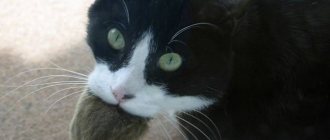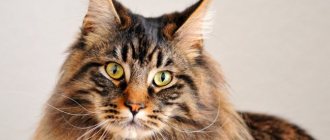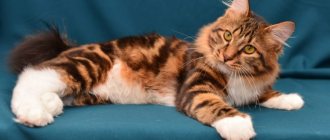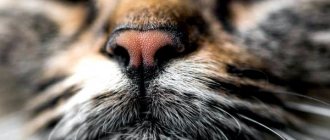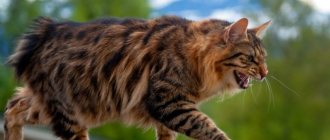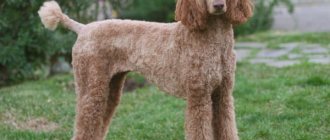Your cat comes from countless generations of ferocious predators. Cats were domesticated approximately 10,000 years ago, meaning they have thousands of years of highly developed hunting instincts. Under the right circumstances, almost any cat will kill a mouse. However, some cats seem to live only to hunt, while others prefer to wait for the occasional mouse to stumble upon near their food bowl.
If you live where mice and other rodents are a problem, here are some tips for finding a cat that will happily catch its prey.
How to teach a cat to catch mice?
Mousecatchers are found among purebred and outbred cats.
In order not to make a mistake, it is recommended to figure out in advance what criteria to choose a kitten by. Attention is paid not to the physical structure, color or breed, but to the parents. If the father or mother is good at catching mice, they will teach the kitten the skill
Therefore, you should first ask the owners how good hunters the parents were. A reasonable option is to go to the nearest village to pick up the kitten. Animals growing outside chase flies, butterflies and other insects, which develops the hunting instinct.
It is difficult to teach a domestic cat to hunt; the instinct must be developed from childhood. The owner needs to purchase appropriate toys, lined with fur, and constantly tease the kitten so that he runs after them. You should develop your pet's agility, reaction speed, coordination and endurance. To attract your pet's attention, the toy can be soaked in a decoction of catnip. As an alternative, you can catch the mouse and show the rodent to your pet. The kitten will interest her. You can only remove a mouse when the animal has had enough of playing with the pest and strangled it.
Instincts or fun
Yard kittens, forced to fight for existence, hunt mice like adults from the age of 5 months. In the USA, they conducted an experiment in which they established a connection between the living conditions of kittens and their hunting reflexes, first by mating purebred and street cats with one cat. The litters, after they were born, were swapped - the purebreds were given to the yard mothers and vice versa.
As a result, it turned out that initial hunting skills were inherent in both groups, since mothers regularly carried mice to their litters. The difference appeared at the next stage: the street cat killed rodents and gave them to kittens, while the purebred cat only played with the mouse.
Important! The researchers concluded that to consolidate the reflex of catching/eating living creatures, instinct alone is not enough, but skills acquired through education are necessary.
On the other hand, a kitten growing up isolated from its fellow cats independently learns the basic wisdom of a cat (washes itself, sharpens its claws, snorts, relieves itself, meows pitifully or angrily) and is quite capable of catching a mouse. Another question is whether he will eat it or not. If a kitten is very hungry, it is unlikely that the lack of a mother's example will stop him.
By what signs can you recognize a rat catcher?
A mousetrap cat is not a breed, but a rare skill that a pet develops due to the conditions of its keeping and upbringing. The best hunters are considered to be mongrel cats, who have had to hunt mice for food since childhood.
Street animals are not spoiled by the attention and care of the owner, so the hunting instinct develops and remains for the maximum period
The following signs will help you recognize a future rat catcher in a kitten:
- if one of the parents is good at catching mice, by four months the skill will be transferred to the kitten;
- female. Cats catch mice better than cats, which is associated with increased activity and fearlessness. To feed her offspring, the mother cat will get food in any way, so her hunting instinct is heightened;
- head shape. Animals with a triangular oriental skull shape have greater potential for catching rats;
- activity in the game. If a kitten runs after ribbons, toy mice and catches them with his teeth, he will make a good hunter;
- physiological characteristics. The pet must be well built, have developed muscles, strong bones;
- high ears with tassels. Allow the pet to track rustles and squeaks, which increases the likelihood of finding a target;
- color feature. It is believed that the best hunters are tri-colored, tortoiseshell, and motley cats.
The listed signs increase the likelihood of a successful hunt. But the development of the skill depends on the conditions of detention and upbringing. If you keep your pet in an apartment and give it food when called, the hunting instinct will “die out.”
The fun process of catching rodents
This cute, fluffy, affectionate creature is a natural enemy of field mice, house mice, and rats. Pests cannot even stand the smell of cats; they avoid their property and fear for their lives.
In cats, the huntress instinct is genetically embedded. Even when well-fed, she will not miss the moment to chase a mouse that suddenly appears. The process itself gives pleasure - to catch, not to miss. But whether to kill, eat or not depends on other factors.
A study was conducted in the USA. They crossed purebred cats and yard cats with one cat. The kittens were swapped after they were born. Purebred cats were raised by yard cats. As a result, it turned out that everyone had developed hunting skills. Mothers regularly brought small rodents to their kittens. But further actions were different. The yard worker killed in cold blood, showed how it should be done to the kittens, and gave them to them to eat. The thoroughbred was limited to playing. The conclusion followed was that in order for kittens to start catching mice and eating them, an example is needed. Instinct alone is not enough; skills are also required.
Who is better at catching mice, a purebred cat or a barn cat?
Both purebred and barn cats have this instinct in the same way. In more reliable hunters it is better expressed. If we consider a purebred cat, then in the course of their evolution, breeders tried to lull the cats’ natural instincts in order to better adapt them to life in an apartment. Therefore, such a cat will catch a mouse, but only out of curiosity, and not in order to eat or kill it.
However, this does not mean that outbreds catch mice better. Especially if they were bred in apartment conditions and have never seen rodents. And even if such a cat does come across a rat or mouse, it will simply play with it, not suspecting that a real hunter should bite it in the back of the head to kill it. And good hunting requires skills.
How to teach or instill in a cat the ability to catch rodents well?
An experiment conducted back in 1960 will help answer this question. In which four cats took part: two purebred and two ordinary hunters. All cats were bred with cats similar to them. After the litter appeared, the kittens were changed, the hunter-murks were given purebred ones, and the purebred ones were given ordinary ones.
After three weeks of age, ordinary hunting cats brought a mouse to “their” kittens and taught them to handle it with special care and precision. At this time, ordinary kittens from “their” purebred mothers learned only games, hunting was absent from their lives
During the experiment, it became clear which cats would be the best hunters - those that lived in special conditions and had experience in catching mice. Therefore, with all the cat's heredity, growing conditions play a key role.
This means that in order to choose a mouse exterminator, you need to know how the kittens were kept.
A kitten from the street or born in a basement is very suitable for this role; from three to five months of age it is already ready and has all the necessary skills for hunting.
If we talk about purebred representatives, then you need to know in what conditions they were raised - if in a suburban area with access to the street, and not in an aviary, then the following breeds are well suited: Russian Blue, Siberian, Kuril Bobtail, Bogatyr - Maine Coon, Bengal .
Appearance of the ratcatcher cat
Which cats are better at catching, judging by their appearance?
Short-haired representatives are considered the best hunters, because with a little rain, the long hair gets wet and begins to smell strongly, which scares off potential prey. And the wool should be appropriately colored: dim stripes and spots, i.e. wild color, it’s easier to blend in with the world around you.
If the pattern is monochromatic, then not bright colors will do: it will not be easy for a white cat to catch a mouse, but for a red, gray, or black cat it will be easier to merge with nature. Our grandparents also say that the more mustachioed the cat is, the more he will catch.
By gender
The sexual instinct of cats interferes with the hunt a little; he would like to find another bride for himself, that’s what’s first in his head. Cats come into heat almost every month. If she gave birth to kittens, she devotes almost all her time to them. But then he is an excellent hunter. Therefore, the cat is probably more diligent, more diligent, and more successful than the cat. And if she is also sterilized, then this is generally wonderful, less thoughts about offspring and walking, more about hunting. Castration of a cat will also correctly influence the right thoughts about hunting, although if before castration he did not particularly like to run after rats, then after that he may not wake up particularly zealous.
Hunger is not a thing...
Why does a cat catch mice? Well, probably to eat? It turns out that if the cat is not fed, it will catch better and catch more? Logical, but not correct. Cats do not catch mice for food. Regardless of whether she is full or not, she will catch the same. For her, fishing is not a way of subsistence, it is something like a game. She needs the fishing procedure itself. And eating is already a nice bonus to the game. By the way, they love simple mice, but they simply kill moles and rats.
Beware the mouse is poisoned
A cat that catches mice every day is at risk of contracting viruses and parasites carried by rodents. Therefore, the owner of a rat-catcher cat should not skimp on vaccinations and other preventive measures.
Apartment trappers are also at risk: the mouse can be poisoned by arsenic or other poison, which can lead to severe poisoning or even death. Allow your cat to eat the mouse only if you are sure of its “purity”.
Is it possible to stop eating mice?
Modern cats (with the exception of those who sit on pasture) have stopped eating caught mice: they are brought to their owners as proof of their dexterity and diligence, often in gratitude for human care. In addition, a cat will not eat a mouse if it has had enough to eat. If you don’t want your pet to eat rodents, watch the energy value of its usual food.
There is an option - to put on a collar with tiny bells: this way, the cat will not only not eat, but, above all, will not catch the mouse . A side effect is the annoying rattling of the bell, which not everyone can withstand. If your cat starts chasing mice at your dacha, build her an enclosure where she can frolic until the evening: in this case, all the day’s prey will remain in the enclosure, and you will take the cat into the house in the evening. This method is also not flawless - most personal plots are not designed for unplanned structures.
This is interesting! The most ingenious development is considered to be the development of one meticulous programmer, who came up with a compact automatic door for his cat named Squirrel. The guy got tired of bumping into cat trophies (strangled mice/birds in different corners of the apartment) and he designed a door that opened in front of the “empty” cat and did not open if he was holding something in his teeth.
The programmer taught the camera standing at the entrance to analyze the image (which was simultaneously broadcast to the web server), comparing it with a template, and make a decision about allowing the object into the house.
It will also be interesting:
Character and behavior of lop-eared animals
The Scotsman is a purebred cat that is distinguished by its kind disposition. Distinctive behavioral traits:
- communication skills and sociability;
- love for children;
- gaiety;
- easy to educate with the right and friendly approach;
- actually cannot be trained;
- playful;
- not mischievous;
- they quickly forget bad things and do not take revenge.
Scottish Folds are an ideal option when there are other animals and children in the house. Such kittens are real aristocrats with their mannerisms and waywardness. Their restiveness and capriciousness are often observed. If the Scots want something, they will definitely achieve it. An adventurous breed with a curiosity for the unknown. When new people appear on their territory, Scottish cats are not very friendly, but then they begin to communicate. Scots love to play, but are not particularly happy with cuddling and cuddling.
Potential Hazards
Is it safe for a cat to indulge in hunting? Not as much as you would like.
Rats, often the prey of cats, are carriers of diseases such as rabies and distemper; they can also be intermediate hosts of fleas and ticks, which are often carriers of piroplasmosis and encephalitis. Birds often carry subcutaneous mites and fungal infections. In addition, street animals can “give” worms to your pet. In cities, rodents are periodically poisoned with rat poison, which, when it enters the cat’s body, kills it.
Owners have phobias of rodents and birds. Phobias should not be confused with fears. The former make a person lose control of himself and cause many unpleasant emotions and problems. If the owner has such deviations, the cat that brought a “gift” into the house may be given to someone else or even thrown out into the street.
There are, of course, indirect dangers. On the street, a cat can be hit by a car, chewed by a dog or another cat, or a pet can run into evil people. The latter is especially true if the cat decides to plunder someone’s chicken coop.
By what external signs can one identify a future mousetrap?
It is believed that a cat that can successfully catch mice must look the part. What signs can be used to determine which kitten will be an excellent rodent exterminator?
Signs of a mousecatcher:
- long mustache;
- wild color - black, red or gray, two or three colors, with faint stripes and spots to blend with nature and remain invisible to its prey;
- short hair – long and thick guard hair when wet acquires an unpleasant odor, which can scare away the rodent;
- large ears and triangular head;
- large paws.
They tried to choose the best rat catcher using these signs several decades ago. In reality, there are no perfect rat hunters. Every cat has a hunting instinct from birth, but not all representatives of the feline family realize it with equal success.
Before you take a kitten into your home to catch mice, you should ask whether its mother was a good hunter. When raising their cubs, cats pass on their skills to them, including in catching rodents.
If the pet was taken from the street, it is highly likely that its hunting skills will be well developed. In purebred pets, the instinct is dulled, especially if several generations of animals have lived in apartments and do not even know what a mouse or rat looks like.
Is it possible to teach a cat to hunt if she doesn't show much desire to catch mice? In order for the animal’s natural instincts to awaken, it is necessary to let the pet feel a slight feeling of hunger. A cat should not be completely deprived of food - this is cruel and fraught with health problems. You just need to reduce the portion size: malnutrition will awaken the instinct in your pet. After the first successful hunt, it is advisable to reward the animal.
You need to teach your pet to hunt from childhood. There is no point in training an adult castrated cat. The purpose of its existence is food and sleep, such animals become lazy and quickly gain excess weight, and it becomes more and more difficult for them to run every year. But you can and should awaken a kitten’s interest in hunting. To do this, catch the mouse using a mousetrap and let your child play with it while it is still alive.
To activate the kitten's hunting instinct, you should play with it more often using a laser pointer or special toys. If your pet tirelessly chases them, he will become a professional in catching mice.
The importance of a pet's appearance
Success in catching rodents depends on the conditions in which the kitten grew up and the appearance of the animal. Color plays a significant role, serving as natural camouflage. The most preferred are discreet fur coat colors: gray, black, brown. A cat with a motley or tortoiseshell color will blend into the surrounding landscape. The second significant point is the length of the coat. When wet, the long fur acquires a specific odor, which serves as a signal for rodents that a predator is approaching. Therefore, short-haired cats find it easier to hunt in the rain.
IT IS IMPORTANT TO KNOW! When choosing a ratcatcher kitten, you need to pay attention to the whiskers . Thanks to the vibrissae, the pet navigates in the dark, picks up air vibrations, and estimates the distance to the mouse.
How to determine if a cat is a rat catcher?
Future owners of furry pets are often interested in which cats are better at catching mice. There is no specific breed that would be designed specifically for catching rodents. However, there are signs by which it can be determined that an animal is predisposed to this. In addition, there are more than one breed of cats that can catch mice and rats.
Animals born and raised in apartment conditions are not always able to cope with catching rodents. The best hunters are cats and cats that grew up on the street. They have well-developed natural instincts and animal habits.
External signs that rat-catching cats should have:
- Large and dense build.
- Long, “L-shaped” tail.
- Short and wide legs.
- Powerful jaws with fangs.
- Long mustache.
- The head is shaped like a triangle.
- The ears are large, with possible tufts at the tips of the ears.
These are the most characteristic signs that allow you to understand that the kitten is a rat catcher. Once the external characteristics that rat-catching cats possess are known, it is worth considering the breeds.
Reasons for eating rodents
When asked why cats eat mice, the answer always arises - because of hunger. The situation when a skinny cat sees a dead rodent and is in no hurry to touch it has dispelled this myth. Then why does the cat eat the mouse?
Nature has established an inextricable connection between cats and rodents. Mouse skin contains many useful trace elements, especially sulfur. They are necessary for the full development of the cat’s body and good health. Sulfur is a component of cystine and mythionine. The components are responsible for the health, beautiful coat, and mood of the cat. Meat should be included in the daily diet. In its absence, pets begin to get their own food.
Indoor cats will not chew mice, since their supply of sulfur comes with vitamins, which the owner constantly supplies them with. There is no feeling of hunger and access to food is unlimited. Therefore, you can see a cat eating a mouse on the street among the yard “residents”.
Cat or cat: who is the better hunter?
If we talk about the gender of mousecatchers, it still seems more reasonable to give the palm to the cat. In cats, the sexual instinct comes first, and if the animal is not castrated, the mustachioed cat can be distracted by “love” all year round, neglecting his hunting duties. We have all seen how skinny and tattered the tailed gentlemen return from their sexual adventures - it is obvious that they had no time for mice.
In cats, the estrus period is usually not long. And, raising kittens, as we said above, they hunt with double zeal and teach their offspring to do so. That is, they have double motivation. And female creatures usually have more persistence and diligence.
Analysis of the dilemma
Every cat is endowed with a hunter's instinct. To do this, you can carry out a simple check. You need to scrape your nails along any rough surface. How does the cat behave at this moment? The faster her reaction to this action, the more serious the possibility that she will begin to catch mice. The reaction may include wiggling the ears and throwing towards the hand.
If a cat was born in an apartment and grew up in an urban home environment, then it will not catch rodents . If in some situation she sees a mouse, she may simply play with it, rather than perceive it as prey. Simply instinct is not enough here. It also takes practice.
A true cat-hunter is very enthusiastic about this matter. She won't stop until she kills her victim. Usually followed by a precise bite to the back of the head. Only a mother can teach these skills. For this reason, cubs raised in yards or basements are good at hunting this way.
© shutterstock
Breeds of rat-catching cats
There are certain breeds in the cat family, whose representatives are distinguished by excellent health, special dexterity and dexterity in catching rats.
Siberian cat
The cat was named Siberian due to its fluffy long hair. She is unpretentious, has a strong build, the weight of cats reaches 7 kg, cats weigh about 9 kg. She has strong paws and excellent grip. Due to the slightly longer hind legs compared to the front legs, the cat has the ability to run and jump quickly. Such animals are obstinate in nature, they have an excellent reaction, which is necessary when catching rats. They are independent and love freedom.
The Siberian cat has a strong build and excellent grip.
Maine Coon
Cats of this breed are distinguished by mobility and strength. Maine Coons are hardy and able to live in regions with harsh climatic conditions. These large animals (males can weigh up to 15 kg) have the nature of a predator; they do not welcome human affection. Due to their size, they can easily deal with rats.
Maine Coons easily deal with rats
This breed of cat is distinguished by straight-set large ears, which have tassels at the ends. Maine Coons have long and thick fur. They have well-developed muscles, a wide chest, strong bones, and a thick and long tail. All this data allows Maine Coons to become a real threat to rodents.
Kurilian Bobtail
A feature of animals of this breed is a short tail, the length of which does not exceed 3–8 cm. But they have strong hind legs, which are longer than the forelimbs. And therefore the Kurilian bobtail runs well, jumps, and deftly strangles rats. Males of this breed weigh about 10 kg, females - 6 kg.
The Kurilian Bobtail is fearless and deftly strangles rats
Such cats are capable of completely destroying a mouse or rat hole. They are easy to train and can be trained. People keep them as companions; they get along easily with other animals. Bobtails have a fearless character.
European shorthair cat
Representatives of this breed destroyed rodents back in the days of Ancient Rome. European shorthair cats are called yard cats and are not considered purebred. However, they are popular in the world and are one of the best rat catchers. The predator's passion and agility help them successfully hunt rats and mice.
European shorthair cats are some of the best rat catchers.
Such cats are distinguished by individuality, independence, grace, and aristocratic appearance. They have a short coat, gray or silver marbled in color.
Cymric
Animals of this breed are similar to ordinary cats, but with a short tail. This structure, along with agility and tenacious claws, makes the Cymric a successful rat catcher.
Agility and tenacious claws make the Cymric a successful rat catcher.
British Shorthair
The hunting instinct and excellent natural inclinations make the British excellent rat catchers. Such cats are calm, friendly, and attractive in appearance. They love to please their owner by bringing him a caught rodent in their teeth in order to exchange it for rewards and something tasty.
Natural inclinations and hunting instinct make British Shorthairs excellent rodent catchers.
Females, weighing an average of 4 kg, try not to attack large rats, hunting only young ones or mice. Often this is enough to avoid a rodent infestation.
Russian blue
Russian blue cats are medium in size and light in weight, but this does not interfere with their hunting habits. Instant reaction and silent movement for a long time make these cats good rat catchers.
The Russian Blue cat has the ability to move silently and react instantly.
The ability of the Russian Blue to react to rodents is a true art: its speed of attack on the prey, accuracy and grace of movements are captivating. This is a thunderstorm of super rats, weighing about 500 g. The Russian Blue does not like partners of other cat breeds, but gets along well with rat catchers of its own breed. Opponent of tenderness from the owner.
Veterinary
We offer professional medical care for pets in Yekaterinburg. We employ experienced veterinarians and use the latest diagnostic and treatment equipment. In addition, we provide services for caring for pets and correcting their behavior, for example, when cats are bad at catching rats and mice.
Reception is carried out in our three branches in the city: at Botanika, VIZ and ZhBI. One of the branches, on Rassvetnaya Street, is open 24 hours a day. In addition, our clients can call a specialist to their home.
Back
Behavior change
There are often cases when cats behave quite aggressively towards household members and guests. Pets are capable of not only scratching furniture, but also attacking. The animal experiences a kind of stress (usually due to dissatisfaction). This behavior goes from episodic to permanent status, since the pet considers it the norm.
The problem can be solved if the animal is sterilized in a timely manner. The cat becomes more accommodating as the source of “indignation” ceases to be relevant
If even several months after the operation the cat still continues to be mischievous, then the cause should be sought in other factors (constant stress, illness, lack of attention, etc.). In the first days after the operation, the animal may behave too calmly
It will seem that in such a short period of time the pet's activity will decrease significantly. But actually it is not. The rehabilitation period for each individual is different. For some, a couple of days are enough to recover, while for others it takes up to several weeks or even months.
The main thing is to provide your pet with complete care. This applies not only to nutrition, but also to attention. After all, the animal needs the support of its owner more than ever.
It is important to find that “golden” mean that will be optimal for creating a postoperative environment for a cat
Recommendations
A hunting cat spends a lot of time outdoors, in contact with other animals, which increases the likelihood of infection and the development of diseases. To protect your pet from diseases, you need to remember the following rules:
- the cat must be periodically vaccinated against potential diseases;
- the pet needs to be fully fed and fortified with vitamin supplements, which will strengthen the immune system;
- every 5 months, clean your pet of worms for the purpose of prevention;
- the animal needs to buy a flea collar that prevents the spread of parasites;
- in early spring, before a walk, it is recommended to treat your pet’s fur with protective sprays, since in May the likelihood of insect attacks increases.
For preventative purposes, you can take your cat to the veterinarian for examination once every six months.
How to raise a hunter
Even breeds in which the hunting instinct is very pronounced, or with heredity conducive to this, will not necessarily become excellent hunters without the proper conditions and education
To help develop it, we recommend paying attention to the following techniques:
Encouragement always plays into the hands of teachers. Praise your pet when he catches prey (but not, of course, if his prey was one of your other pets); One might assume that if an animal has nothing to eat, it will inevitably become a hunter, but this is not so. If you start starving your cat, most likely he will start stealing and searching garbage dumps, but will not join in the hunt. Feed your pet often, but in small portions. The bowl should not be kept full all the time; Games are a good stimulant
By playing, you will help the kitten develop the hunting instinct, but you should not get too carried away with this, because by fully satisfying the need for hunting with fun, you can discourage the cat from switching his attention to mice and other pests. As one of the options for developing the hunting instinct, you can use a live mouse, which you yourself will give to the kitten
You can pick it up only after the pet has played with it and strangled it.
Little hunter
The optimal age at which you can take a kitten from its mother is four to five months. By this time, your pet can already learn the basics of hunting science from its parent. Also, the future hunter needs to be constantly vaccinated, including against rabies, treat the fur with sprays, buy a flea collar and periodically treat for worms, since as a result of hunting your pet may become prey to various parasites.
Hunting instinct in cats
Hunting instinct is the level of an animal's natural interest in hunting live prey. Even domestic cats have it and can easily be tested at home. To determine how developed the hunting instinct is, you need to scratch your fingers on the surface. The faster a cat reacts to a sound, the higher its level of interest.
Cat hunting consists of several mandatory stages, including:
- prey detection;
- sneaking up on the victim;
- decisive shot;
- holding with teeth.
The hunting instinct is well manifested in games with a pet. Before throwing, the animal freezes and begins to sway, tensing its body. If the prey escapes, the cat expresses dissatisfaction with its voice.
The level of development of the hunting instinct is influenced by the conditions of keeping animals. Cats living in apartments catch mice for fun. Yard cats are more adapted to hunting and do it not out of interest, but for food.
On a note. All kittens from birth have the makings of a predator. But they learn hunting techniques from their mother. If kittens do not learn the appropriate skills at an early age, they will not catch mice in the future.
How to identify a ratcatcher cat
The first thing you should pay attention to is the color of the animal. Representatives with gray, black, brown, red skin blend better with nature and, as a result, are more successful hunters
White, unfortunately, in this case, is the most losing.
The second point is education
It is very important how the kitten behaved in childhood. Outdoor games with a bow, a ball, chasing the light of a laser pointer - all this is the preparation and development of hunting instincts
In addition to these important points, rat-catching cats also have the following features:
- Scientists, veterinarians, and breeders note the fact that there is a well-defined gender difference in the manifestation of the hunting instinct in cats. Cats are considered more effective rat catchers than cats. The thing is that by nature, females have the understanding that they must feed not only themselves, but also their offspring, therefore, in terms of obtaining food, they act more actively and consciously.
- Those cats that catch mice and rats differ from their counterparts in the shape and structure of their heads. It is believed that animals with a skull whose outline is close to triangular are more capable of hunting than others.
- The presence of high tufted ears and a bushy mustache is another sign of a rat catcher. This anatomical structure ensures high sensitivity: the hairs react to any, even the slightest, air vibrations.
- The breed of rat-catcher cats is of great importance. In this matter, you cannot choose artificially bred representatives. Such selection has a negative impact on skills and dulls natural instincts.
Interesting! Yard cats and female cats are excellent mousecatchers. The point is also that they develop their instincts from childhood. Hunting for them is a way to survive.
An equally interesting question is whether the rat-catcher cat will continue to hunt after castration. The animal's behavior changes after this operation, but this does not mean that it will lose its innate and developed instincts. The only thing you should be careful of in this situation is overfeeding your pet. Such measures often lead to obesity, and, as a result, hunting skills decrease. Therefore, a neutered cat should be given a special diet, so that he will continue to perform the task assigned to him.
Some rat hunters may be affectionate in nature, while others may be unsociable. There are animals that want to please their owner and often catch rats to show him their love. And there are cats that avoid people and do not welcome affection, but this is also quite normal.
Is it possible to teach an animal to hunt rodents?
The kittens are taught hunting skills by their mother, but in her absence the owner has to do this. Animals living outside hone their skills not only on rodents, but also on insects. At home, they can be replaced with special toys: teasing fishing rods, jingling balls, a laser pointer and wind-up mice.
IMPORTANT!
Do not starve your pet to awaken its predatory instincts. It will not spur him on to hunt, but will simply deprive him of his strength.
It is almost impossible to achieve results as an adult, so games with catching moving objects should be introduced in childhood, before 4 months. Be sure to give your pet the opportunity to take possession of the toy and praise him for catching the prey. Thanks to regular training, he will be able to hunt on par with those who were trained by his mother, but with one difference - the absence of the desire to kill and eat caught prey.
Popular rat catcher breeds
A cat's tooth fell out: main symptoms and treatment options
As already mentioned, in the matter of choosing an animal for catching rodents, the breed is not the least important. There are a number of felines that are endowed with a strong hunter gene. If we consider purely physical data, they will differ in the above characteristics.
Russian blue
One of the most prominent representatives. The Russian Blue is not one of those who will sit in ambush for hours and watch its prey. She attacks quickly and swiftly, almost always overtaking her target.
Russian Blue has a good upbringing. A cat will rarely allow itself to scratch furniture and wallpaper, or stir up flowers. Representatives of this breed have a good memory. Having learned to hunt once, they will do it constantly.
Russian blue
Siberian cats have good health, well-developed muscles, powerful paws and an elongated neck. Their thick, long fur has a dark, striped color. These are one of the few long-haired representatives that are excellent hunters.
Siberian cats easily and quickly overtake their prey, and their long claws do not allow it to escape. They are very patient and can stalk their prey for hours, waiting for the best moment.
In relationships with people they prefer to maintain a distance. They are not as trusting and attached to humans as other breeds. The Siberian cat easily gets used to any change of environment, therefore, even if the pet is moved to a private house, it will quickly get used to it there.
Important! The Siberian breed does not require special care. A distinctive feature is that they need regular walks in the fresh air (even in winter)
Maine Coon
The Maine Coon is a breed that was originally bred to control rodents and other pests. The main advantage is their size. Such dimensions help to fight even the largest enemy. They are fluffy and come in a wide variety of colors. A characteristic feature of this breed are medium-sized straight ears with a tassel at the tip.
For your information! The most interesting thing is that Maine Coons can get along with domestic rodents (like hamsters), but at the same time catch pests.
Maine Coons do not like confined spaces; they need freedom, a place to play and run. Therefore, it is best to keep such large animals in a private home. It is also worth remembering the special care that representatives of this breed require.
Cymric is not known for its large size. The main difference is that they almost completely lack a tail. This feature resulted from incest. However, such moments do not prevent Cymrik cats from being the best hunters. Experienced breeders recommend keeping representatives of this breed in spacious premises. This is exactly what a private home is, where they can fully realize their potential and splash out their energy.
Despite the lack of a tail, the Cymrik is distinguished by a very agile body and long llamas. The hunter quickly and easily overtakes his prey.
Note! Cymrik has been a rat catcher since birth. Cymric
Cymric
Representatives of this breed are often confused with yard murziks. According to historical data, the European Shorthair comes from Ancient Rome and even then established itself as an excellent hunter.
The color is silver marbled or gray. They love a lot of space, but can live in a city apartment. Quite unpretentious in care.
Important! They prefer to keep their distance from other animals and children.
Kurilian Bobtail
Representatives of this breed appeared in Russia relatively recently (at the beginning of the 20th century). These animals were brought from the Kuril Islands. Very affectionate and devoted to people. Their character traits are reminiscent of dogs.
We invite you to familiarize yourself with Antique Bathhouse Finishing
Why are they good hunters? Precisely because of his affection. Even as a kitten, the Kurilian Bobtail tries in every possible way to please its beloved owner. Therefore, it is worth preparing for the fact that all the caught prey will be brought home and demonstratively eaten.
The breed is distinguished by a small tail and body, similar in structure to a lynx. The hind legs are longer and more powerful, which allows them to quickly gain speed when chasing prey.
Kurilian Bobtail
Characteristics of rat-catching cats
There are several basic signs that allow you to determine how good a rodent hunter a cat will be. Among them:
- head shape (felinologists have found that the best rat catchers are animals whose skull outlines resemble a triangle);
- muscular body with strong paws;
- protruding ears with tassels;
- bushy mustache;
- powerful jaw;
- variegated, usually three-color coloring (helps with camouflage);
- short hair (in wet weather, long hair emits a stronger odor that rodents can smell from afar).
But cats eating rats or simply catching them, obeying instinct, is unlikely to affect the hunter’s talent. Character is also not a decisive factor - rat catchers can be affectionate and playful, or they can behave with restraint and even sternness. But of course, a good hunter must be brave and decisive, because a cornered rat can even attack a cat.
Situations have been recorded where a rat killed a cat by grabbing its throat. True, such situations occur extremely rarely; more often the rodent tries to escape.
Questions about breeds and external characteristics.
As has already been noted, the best mousecatchers are cats raised in appropriate conditions.
Although some experts insist that there are still breeds of mousecatchers. These are all European cats with short hair. In this category, the following are distinguished by color:
- European tabby. Outwardly, it resembles a small tiger. Cats of this breed are very strong and stocky. They don't just catch mice, they ruthlessly destroy them.
- European speckled. These are good mouse hunters of various parameters. They also catch lizards, snakes, small birds and fish.
shutterstock
Why does a cat bring prey to its owner?
Many cats bring their trophies to their owner, sometimes even to bed. There is no point in scolding them for this - this is how they express their love and affection. A corpse found on a pillow is not the most pleasant picture, but the pet that brought you the trophy still needs to be praised and rewarded. A negative reaction or lack thereof can discourage hunting.
Regardless of the breed of rat catcher you choose, be sure to vaccinate it against rabies. This will protect it from death if infected.
Do you like the article? 0
Mice in the diet - harm or benefit
Rodents are as beneficial as they are harmful to cats, at least according to veterinarians who are concerned about the “bouquet” of diseases transmitted by the former. It is believed that mice (like rats) are carriers of infectious diseases that are dangerous both for the pets themselves and for their owners.
The list of such diseases includes:
- trichinosis - difficult to treat and caused by helminths that parasitize the intestines (larvae penetrate muscle tissue and destroy it);
- ringworm (ringworm) is a fungal infection that affects the appearance of the coat/skin. The therapy is simple but long-lasting;
- leptospirosis - affects various organs and is accompanied by fever. A cat becomes infected through contaminated water, eating mice or coming into contact with their secretions;
- toxoplasmosis is dangerous for pregnant women and is often asymptomatic. About 50% of rodents are considered carriers of the disease;
- salmonellosis is an acute intestinal infection that threatens humans and animals;
- tularemia, pseudotuberculosis and others.
Hypothetically, a cat that eats mice could become infected with rabies, but this probability is reduced to zero if the animal is vaccinated. The second thing that should reassure the owner is that the virus is transmitted through saliva, that is, the mouse must injure the cat.
Important! Those who live in private homes and keep rat-catching cats say that their animals hunt rat mice for many years, avoiding any infectious diseases. Several generations of cats live to a ripe old age, enriching their daily diet with rodents without tragic consequences for health.
A cat is more likely to be poisoned if it tastes a mouse that has died from the poison used in deratization. If the poisoning is mild, you can get by with pharmaceutical absorbents; in case of severe poisoning (vomiting, diarrhea with blood, liver/kidney failure), call a doctor immediately. Also, when in close contact with rodents, pampered domestic cats often pick up fleas or helminths.
Principles of healthy eating
Biologists and doctors know that any amino acid performs two related functions - it supplies building material to protein chains and supplies the body with energy. Animals often need amino acids from outside, since they are not able to produce them themselves. Such amino acids are called essential. In cats, this is taurine - it is not produced in the body, but is responsible for the performance of its main organs.
Zoologists have found that the highest concentration of taurine is found in the retina of a cat's eye (100 times more than in the blood). This is why taurine deficiency primarily affects vision: the retina degenerates, and the animal quickly and irreversibly goes blind.
In addition, taurine takes care of the heart muscle, where it accounts for half of all free amino acids. Taurine regulates the transport (from and inside the cell) of calcium ions, facilitating heart contractions. A lack of amino acids immediately affects the activity of the cardiovascular system, causing such a terrible disease as dilated cardiomyopathy.
Important! Whatever your cat’s diet (natural or made from industrial food), the main thing you must ensure is the presence of taurine in it.
Taurine, recognized as an effective antioxidant, has a number of additional, but no less important tasks:
- regulation of the nervous system;
- formation of active immunity;
- normalization of blood clotting;
- maintaining reproductive functions;
- synthesis of bile salts, without which fats in the small intestine are not digested.
Special test
Testing was organized in the 60s of the last century. Its participants were four cats and their children. Two of them belonged to the category of purebred individuals and lived in apartment conditions all their lives. The other two were from a rural yard. The first cubs were conceived from cats from the same category. The offspring of the latter appeared from the neighbors' yard cats.
When the kittens were first born, they were specially replaced. Pedigree mothers were given rural kittens, and village cats were given purebred kittens. All mothers in this test warmly accepted and then raised their babies.
As a result, urban children grew up very playful, but poorly suited for hunting. And the village cats taught purebred children this craft, and they became excellent at catching mice.
It turns out that those cats are better at catching mice that were raised and lived in a certain environment where catching mice is just an everyday practice.
If you need a cat or cat that is excellent at catching mice, you need to ask around the villagers . You can adopt a kitten born and raised on the street.
Even if street cats became pregnant by domestic cats, their cubs still grew up to be excellent hunters.
And domestic cats, which for some reason ended up on the street and got lost, did not get used to catching mice. They either died or fell into good hands.
